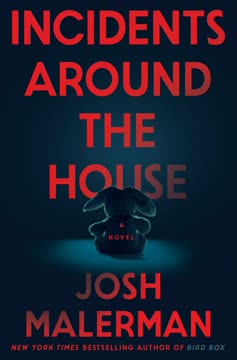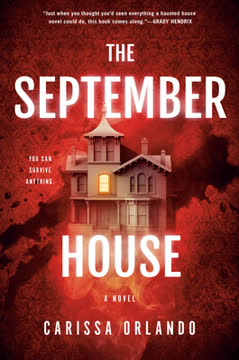Plot Summary
The House Awakens
In the woods outside Sumner's Mills, a group of girls discovers the Octagon House, a long-abandoned, oddly shaped home with a sinister reputation. The house, hidden and decaying, exerts a magnetic pull on the young, especially girls, who pass down stories of its darkness. When the girls enter, they find a metal door to the basement, sealed and foreboding. One girl, compelled by a voice only she can hear, lingers at the threshold, feeling the house's hunger for attention. The house, dormant for years, is roused by their presence, and a cycle of curiosity and fear is set in motion. The house is not just a setting, but a living entity, waiting for someone to return and awaken its secrets.
Return to Sumner's Mills
Clare, now an adult, is drawn back to Sumner's Mills after learning her childhood friend Abby has attempted suicide in the Octagon House. The town is a shadow of its former self, scarred by economic decline and environmental damage. Clare's return is fraught with personal grief—her mother's death, her father's departure, and a recent miscarriage. She is haunted by memories of the house and her fractured friendships. The past and present blur as she revisits old places, feeling both alienated and compelled to confront what happened years ago. The house's pull is as strong as ever, and Clare senses that unfinished business awaits her.
Old Friends, New Fears
Clare reconnects with Lori, one of her childhood friends, and learns more about Abby's recent actions. Lori's family farm borders the woods where the Octagon House stands, and she reveals the house's dark history: a family murdered in the 1960s, rumors of curses, and the house's strange effect on girls. Lori's own stepdaughter, Taylor, has been drawn to the house, experiencing nightmares and compulsions. The friends' conversation is laced with guilt, silence, and the power of testimony, suspicion, and the realization that the house's influence persists across generations. Clare is forced to question her own memories and the role she played in Abby's trauma.
The Fischer Family Tragedy
In 1965, Benjamin Fischer moves his wife Natalie and daughters Joan and Molly into the Octagon House, hoping for a fresh start. The house, however, is isolating and unsettling. Natalie becomes increasingly anxious, Joan is plagued by strange sounds, and the family's tensions mount. One night, tragedy strikes: Natalie is killed, Molly dies, and Joan is left severely injured. Ben is accused of the murders, but he cannot remember what happened. The house's basement, with its heavy metal door, is the scene of the horror. Decades later, Ben, now elderly and released from prison, is still tormented by the events and the possibility that something in the house was responsible.
Childhood Dares and Betrayals
In 1998, Clare, Abby, Lori, and Monica, on the cusp of adolescence, dare each other to enter the Octagon House. The visit is fraught with tension—jealousies, secrets, and the desire to prove bravery. Inside, the girls are drawn to the basement door. Clare, angry at Abby for a perceived betrayal, dares her to go down the stairs. When Abby does, Clare impulsively shuts the door, trapping her in darkness. The others panic, and when they finally get the door open, Abby is traumatized. The incident fractures their friendship and sets Abby on a path of lifelong fear and obsession with the house.
Into the Basement Darkness
The trauma of the basement incident lingers for years. Abby is never the same, plagued by nightmares and a sense of being haunted. Clare tries to rationalize what happened, convincing herself and Abby that it was just fear and imagination. But the memory of the basement, the sense of a presence, and the image of a doll at the bottom of the stairs refuse to fade. The house's influence seeps into their lives, manifesting as guilt, mental illness, and a compulsion to return. The basement becomes a symbol of everything left unspoken and unresolved.
Haunted by Loss
As adults, Clare and Abby are both marked by loss—Clare by her mother's death and a miscarriage, Abby by her mental health struggles and the dissolution of her family. Their friendship, once a source of comfort, is now a reminder of pain and betrayal. Clare's return to Sumner's Mills forces her to confront the ways she has avoided grief, using movement and distraction to keep memories at bay. The house, and especially the basement, becomes a metaphor for the hollow places inside them, where pain and secrets are buried but never gone.
Generations of Secrets
Clare investigates the origins of the Octagon House, meeting Marion Janssen, the sister of its builder, George Sumner. Marion reveals that the house was built for George's fiancée, Alice, and her daughter Grace, both of whom disappeared mysteriously in 1936. Rumors of George's predatory behavior and the presence of "strays" he took in swirl through the town's history. Marion, wracked by guilt and fear, has kept the house standing out of a sense of duty and dread. The house's curse is not just a story—it is a legacy of violence, secrets, and the silencing of women and children.
Abby's Descent
Abby, unable to escape the house's grip, returns as an adult, seeking answers and perhaps release. She visits Ben Fischer in his nursing home, desperate to understand what happened in the basement. Abby's mental state deteriorates as she becomes convinced that the house is haunted by Grace, the lost child, and that only by confronting the basement can she break the cycle. She overdoses in the house, leaving behind cryptic messages for Clare. Her actions force Clare and others to reckon with the possibility that the house's evil is real and must be confronted directly.
The Doll's Silent Witness
The recurring image of a doll in the basement becomes central to the mystery. The doll, once belonging to Grace, is seen by multiple perspectives—Joan Fischer, Abby, Taylor, and Clare herself. It is both a lure and a warning, a symbol of innocence lost and the persistence of the past. The discovery of the doll, along with other artifacts hidden in a tunnel beneath the house, reveals the truth: George Sumner murdered Alice, Grace, and other children, burying their remains and their belongings beneath the house. The doll is Grace's silent witness, her plea for release.
The Past Repeats
Taylor, Lori's stepdaughter, is drawn to the house, compelled by the same forces that ensnared Abby and Joan. She plans to burn the house down, believing it is the only way to end the curse. Clare intervenes, realizing that the only way to break the cycle is to confront the basement herself. She enters, finds the tunnel and the grave goods, and encounters the ghost of Grace. In a moment of terror and clarity, Clare faces the darkness, both literal and metaphorical, and is nearly lost herself before being rescued by Lori and Mitchell.
Unraveling the Curse
The Octagon House is finally destroyed by fire, its secrets buried and its power broken. Clare, Abby, and Taylor begin to heal, each finding their own path to forgiveness and peace. The community, long haunted by rumors and tragedies, can finally move forward. Clare and Mitchell rekindle their relationship, and Abby slowly recovers in a rehabilitation center. The act of burying Grace's doll in Clare's mother's lavender garden becomes a symbolic gesture of closure and remembrance, honoring the lost and allowing the living to let go.
The Tunnel and the Truth
The discovery of the tunnel beneath the house, filled with the belongings of missing children and women, confirms the worst suspicions about George Sumner. The house was built as a monument to his crimes, a place where the innocent were lured, trapped, and silenced. The curse is not supernatural, but the legacy of violence, denial, and the failure to listen to those in pain. By unearthing the truth, Clare and the others are able to break the house's hold and begin the process of healing, both personally and for the community.
Fire and Forgiveness
The burning of the Octagon House is both an act of vengeance and liberation. The fire consumes the physical structure, but also the shame, guilt, and secrets that have festered for generations. Clare, having faced her own darkness, is able to forgive herself and others. Relationships are mended, and the survivors find new purpose. The community, once defined by its haunted house, can now define itself by resilience and hope. The fire is not just an ending, but a necessary step toward a new beginning.
Spring's New Beginning
Months after the fire, Clare returns to the site of the Octagon House and finds it transformed. Crocuses bloom where the basement once yawned, and the air is filled with the promise of renewal. Clare, now expecting a child with Mitchell, feels the weight of the past lifting. The act of burying Grace's doll in her mother's garden, surrounded by lavender, is a final act of remembrance and peace. The cycle of trauma is broken, and the future is open. The story ends not with horror, but with hope, as spring brings new life to a place once defined by loss.
Characters
Clare Madden
Clare is the novel's protagonist, a woman marked by childhood trauma, grief, and guilt. Her mother's early death, a fractured friendship with Abby, and a recent miscarriage have left her emotionally adrift. Clare's return to Sumner's Mills is both a physical and psychological journey—she is compelled to confront the past she has tried to outrun. Her relationship with Abby is complex, defined by love, betrayal, and a shared secret. Clare's arc is one of reckoning: she must face her own role in Abby's trauma, the reality of the house's evil, and her capacity for forgiveness. Through her, the novel explores the interplay of memory, guilt, and the possibility of healing.
Abby Lindsay
Abby is Clare's childhood best friend, forever changed by her experience in the Octagon House's basement. Sensitive, imaginative, and emotionally fragile, Abby is haunted by what she saw and felt in the darkness. As an adult, she struggles with mental illness, addiction, and a sense of being cursed. Her obsession with the house leads her to seek out Ben Fischer and ultimately to a near-fatal overdose in the basement. Abby's journey is one of desperate searching—for answers, for release, for someone to believe her. Her relationship with Clare is both a source of pain and, ultimately, a path to reconciliation.
Mitchell Lindsay
Mitchell is Abby's older brother and Clare's adolescent crush, later her lover. Charismatic and responsible, he is haunted by his perceived failure to protect Abby and by the family's unraveling. As an adult, he is successful but emotionally guarded, shaped by years of watching his sister suffer. His relationship with Clare is marked by longing, regret, and the hope for redemption. Mitchell's arc is about accepting the limits of his control and learning to forgive himself and others for the past.
Lori Farley
Lori, one of Clare's childhood friends, is the most grounded of the group. Now a mother and farmer, she is skeptical of the supernatural but fiercely protective of her family. Her stepdaughter Taylor's struggles force her to confront the house's influence and her own limitations as a parent. Lori's relationship with Clare is rekindled through crisis, and she becomes a source of support and tough love. She represents resilience, the importance of community, and the challenge of breaking cycles of trauma.
Taylor Farley
Taylor is Lori's stepdaughter, a preteen girl who becomes the latest in a line of girls compelled by the Octagon House. Sensitive and isolated, Taylor experiences nightmares and compulsions, mirroring Abby's earlier descent. Her near-tragedy galvanizes the adults to finally destroy the house. Taylor's arc is one of vulnerability and survival, highlighting the intergenerational nature of trauma and the need for intervention and understanding.
Benjamin Fischer
Ben is the patriarch of the Fischer family, wrongly convicted of murdering his wife and children in the 1960s. Elderly and dying, he is haunted by fragmented memories and the possibility that something in the house was responsible. His interactions with Abby provide crucial clues to the house's history and the truth of what happened. Ben embodies the novel's themes of memory, guilt, and the destructive power of secrets.
Marion Janssen (née Sumner)
Marion is the sister of George Sumner, the house's builder. Elderly and frail, she is burdened by the knowledge of her brother's crimes and her own complicity in keeping the house standing. Marion's revelations about Alice and Grace, and her eventual decision to let the house be destroyed, are pivotal. She represents the weight of generational trauma and the difficulty of confronting family evil.
George Sumner
George is the enigmatic builder of the Octagon House, whose crimes against women and children are the true source of the house's curse. Charismatic and controlling, he lures vulnerable people to their doom, burying their remains and belongings beneath the house. Though long dead, his legacy of violence and denial haunts the living. George is the embodiment of the evil that festers when secrets are kept and victims are silenced.
Alice Carey and Grace
Alice, George's fiancée, and her daughter Grace are the original victims whose disappearance sets the house's curse in motion. Alice is a survivor, seeking safety for herself and her child, but ultimately betrayed. Grace, whose doll becomes the story's central symbol, is the innocent whose plea for help echoes across generations. Their fate is a reminder of the cost of ignoring the vulnerable and the importance of bearing witness.
Natalie, Joan, and Molly Fischer
Natalie, Ben's wife, and their daughters Joan and Molly are the family destroyed in 1965. Natalie is a mother struggling with isolation and fear; Joan is a curious, sensitive child who survives but is institutionalized; Molly is the youngest, lost to violence. Their story is a microcosm of the novel's themes: the dangers of denial, the vulnerability of children, and the way trauma ripples outward, affecting all who come after.
Plot Devices
Nonlinear Narrative and Multiple Perspectives
The novel employs a nonlinear structure, shifting between Clare's present-day perspective, flashbacks to her childhood, and historical chapters from the points of view of the Fischer family, Alice, and Marion. This mosaic approach allows the reader to piece together the house's history alongside the characters, building suspense and deepening emotional resonance. The use of multiple perspectives highlights how trauma is experienced, remembered, and transmitted across generations.
The Haunted House as Living Entity
The Octagon House is more than a setting—it is a character, a vessel for the accumulated pain, secrets, and violence of those who lived and died within its walls. The house's architecture (the octagon, the metal basement door, the hidden tunnel) is symbolic of entrapment and the cyclical nature of trauma. The house's influence is psychological as much as supernatural, blurring the line between haunting and mental illness.
The Doll as Symbol and Plot Catalyst
The recurring image of the doll—seen by Joan, Abby, Taylor, and Clare—serves as a tangible connection between the house's original victims and those who come after. The doll is both a lure and a warning, a silent witness to violence and a plea for rescue. Its eventual burial is a ritual of closure, allowing the living to honor the dead and break the cycle of harm.
Guilt, Silence, and the Power of Testimony
The novel explores how guilt—personal, familial, and communal—can be as destructive as any ghost. Characters are haunted not just by what they have seen, but by what they have failed to say or do. The act of bearing witness, of finally telling the truth (whether about George's crimes, Clare's role in Abby's trauma, or the reality of mental illness), is depicted as both painful and necessary for healing.
Foreshadowing and Recurrence
The story is structured around recurring motifs—girls drawn to the house, the basement door opening and closing, the appearance of the doll, the compulsion to return. These patterns create a sense of inevitability and dread, but also set up the possibility of change. The final destruction of the house and the blooming of flowers in the clearing signal that the cycle has been broken, and new life can begin.
Analysis
Beneath the Stairs is more than a ghost story—it is a nuanced exploration of how violence, secrets, and unacknowledged pain echo across generations. The Octagon House, with its haunted basement and hidden tunnel, is a powerful metaphor for the places inside us where we bury what we cannot face. The novel interrogates the line between the supernatural and the psychological, suggesting that the real horror lies not in ghosts, but in the consequences of silence, denial, and the failure to protect the vulnerable. Through Clare's journey—from guilt and avoidance to confrontation and forgiveness—the book argues for the necessity of bearing witness, telling the truth, and honoring the lost. The destruction of the house and the burial of Grace's doll are acts of both mourning and liberation, allowing the living to reclaim their futures. Ultimately, the novel offers hope: that cycles of trauma can be broken, that healing is possible, and that spring can come even to the most haunted ground.
Last updated:
Review Summary
Beneath the Stairs by Jennifer Fawcett is a haunting debut novel about a creepy octagonal house and childhood trauma. Many readers found it atmospheric and engaging, with well-developed characters and an intriguing plot. The story alternates between multiple timelines, exploring the house's dark history. While some praised the suspenseful writing and gothic elements, others felt it was too slow-paced or repetitive. Critics noted unresolved plot threads and a somewhat disappointing ending. Overall, reviews were mixed, with most readers appreciating the eerie atmosphere but some finding the execution lacking.













